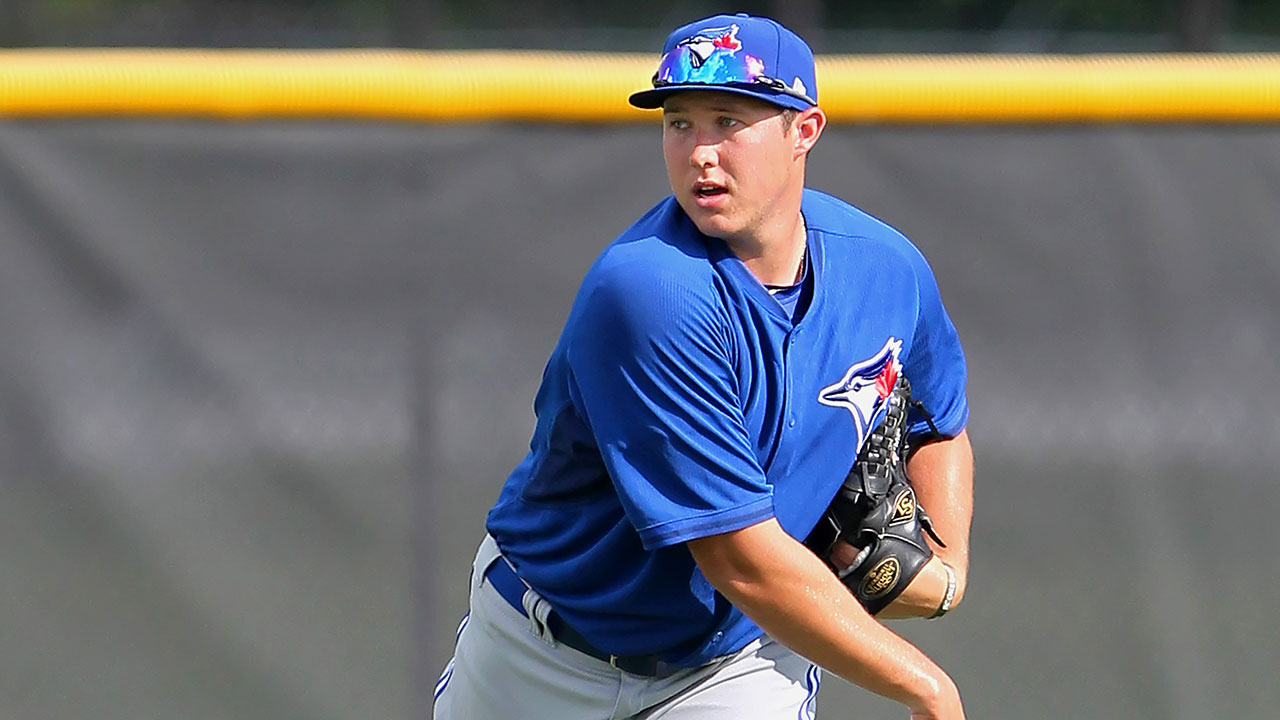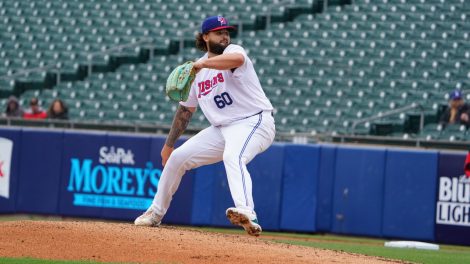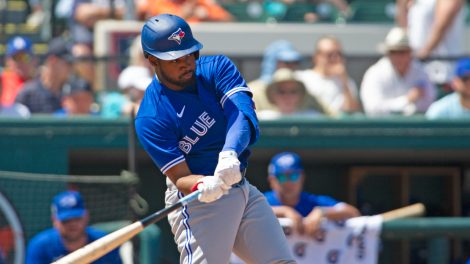TORONTO – Roughly 45 minutes into a wide-ranging conversation examining the Toronto Blue Jays farm system this year, Gil Kim pauses mid-sentence after being struck by a thought.
"It’s weird not talking about Bo, Vladdy and Cavan anymore," the player development director says with a chuckle. "It never got old talking about those guys because we love them and were excited about them. We were fortunate to be able to grow in line with those guys, too. It’s literally for three years we’ve been talking about the same guys."
Well, not anymore, not after Vladimir Guerrero Jr., Bo Bichette and Cavan Biggio graduated to the big-leagues, with Trent Thornton, Jacob Waguespack, Jordan Romano, T.J. Zeuch, Anthony Kay and Yennsy Diaz also debuting in the majors. Danny Jansen, Rowdy Tellez, Reese McGuire, Billy McKinney, Jonathan Davis, Anthony Alford, Ryan Borucki, Thomas Pannone, Sean Reid-Foley and Justin Shafer each parlayed touches late last year into more opportunity in 2019, too.
That’s a massive cohort of transitioning players.
"If you just look back at the summer of 2016, T.J. Zeuch, Bo Bichette, Cavan Biggio and Vlad Guerrero were all playing their first seasons in professional baseball. Jordan Romano was rehabbing (after Tommy John surgery) and had never pitched above (rookie-ball) Bluefield. So it’s definitely exciting," says Kim. "But it also sends a clear signal to us and to other players how important each and every day is, how important each and every practice is, every game is, every single repetition is. You might think that you have so much time to develop and you might think that you have several years to learn and grow, but really, these things can happen quite quickly."
[snippet id=4722869]
To continue advancing the Blue Jays’ rebuild, the farm system will need to keep the graduations coming, particularly on the pitching side, next year and beyond. Front and centre in that regard is right-hander Nate Pearson, the club’s top prospect now that Guerrero and Bichette are doing their damage in the majors.
Pearson and his triple-digit velocity will be knocking on the door next spring, although the legitimate issue of managing his inning count — along with the sketchier issue of managing his service time — means he’s not likely to break through out of the gate.
Regardless, the 23-year-old’s progress this year is a prime example of how industry-wide trends in player development are being reflected in the Blue Jays system.
Pitching in the Arizona Fall League last year, Pearson realized that he could get more swing and miss with his slider by reducing the velocity and increasing the depth on the pitch. In January, he and a handful of Blue Jays player development staffers, Kim included, went to the Driveline Baseball facility in Seattle where Pearson underwent a biometric assessment to identify deficiencies in his delivery and a breakdown of his pitches, information that was then carried through over the course of the year.
Jim Czajkowski (who Kim calls Cy), the pitching coach at advanced-A Dunedin where Pearson opened the year, and Evan Short, the club’s player development and performance analyst, analyzed Pearson’s side sessions using Rapsodo data on spin rates and axis, along with an Edgertronic camera to examine in precise detail how the ball comes off his fingers.
The Blue Jays then "combined that with what Nate is feeling and what Cy is seeing" to refine the offering, explains Kim.
Another example can be found in the leap forward Maximo Castillo, a 20-year-old right-hander who posted a 2.69 ERA over 130.1 innings at Dunedin, took in improving the sink and location of his changeup.
"TrackMan provided in-game results, and side sessions utilized a combination of Rapsodo, Edgertronic, Maximo’s feedback and Cy’s eyes to make the necessary adjustments," says Kim.
"Throughout all of all the implementation of data and technology, the feel aspect and the experience of a Cy, the knowing the feel and timing of when to interject, when to push forward, when to hold back a little bit, those things are very important," he adds. "Cy’s done a really good job this year of applying his experience and his knowledge with some of these newer resources."
The feel piece is, in many ways, the most crucial element.
While some players embrace the deluge of data available, others want no part of it and clubs must be wary a one-size-fits-all approach to development.
As Kim puts it, teams need to "know what to share, when to share it and who to share it with. Both approaches should be respected."
"What we have to make sure we do as we’re further into this, we have to understand each individual and then we have to also know how much of this we should share," he continues, "because it really is about helping the guy get better, versus it is not about a new fancy toy we have to use for everybody."
To that end, a coaching staff with a diversity of skills — experience in the big-leagues, a feel for people, proficiency with data technology, high-performance expertise with the ability to connect with players — is the ideal the Blue Jays seek.
The group at Dunedin was in some ways a prototype.
"They did a very nice job of leveraging all different angles and resources to help the players, but then also creating a competitive fun team environment, too," says Kim.
All of which will be applied to 2020, when the machine needs to keep churning out players for a big-league program in need of more talent.
"We’ve put a lot of emphasis on individualized development plans and purposeful practice environments, and we’re encouraged by the individual skill development we’ve seen with our players," says Kim. "Going forward we plan to continue focusing on helping each player get better individually while at the same time helping to prepare these players to compete and win to the highest standards possible."
[relatedlinks]
Here’s a look at how the Blue Jays affiliates finished along with some updates from Kim on select players in the system:
Triple-A Buffalo Bisons
Record: 71-69
Finish: Third in International League’s North Division
Sean Reid-Foley: Hard-throwing righty struggled with his command and a drop in velocity over 120.2 innings between the Blue Jays and Buffalo, becoming so erratic that the club decided against making him a September call-up.
"For Sean, it’s extremely important to have a really good off-season in terms of his physical development and doing everything he possibly can do to improve with his pitching. We think there are some aspects of his physical development that he can take some steps forward with. The aspects of strengthening, of mobility combine to help a guy with his delivery, help a guy with pitching. Those are the conversations right now and it’s trying to figure out the best ways to attack the off-season."
Julian Merryweather: Right-hander coming off Tommy John surgery was expected to get a call-up at some point this year but experienced soreness while on rehab leading the club to back off. He’s throwing but won’t pitch competitively again this year.
"We’re going through what’s the most optimal (off-season) plan for him right now."
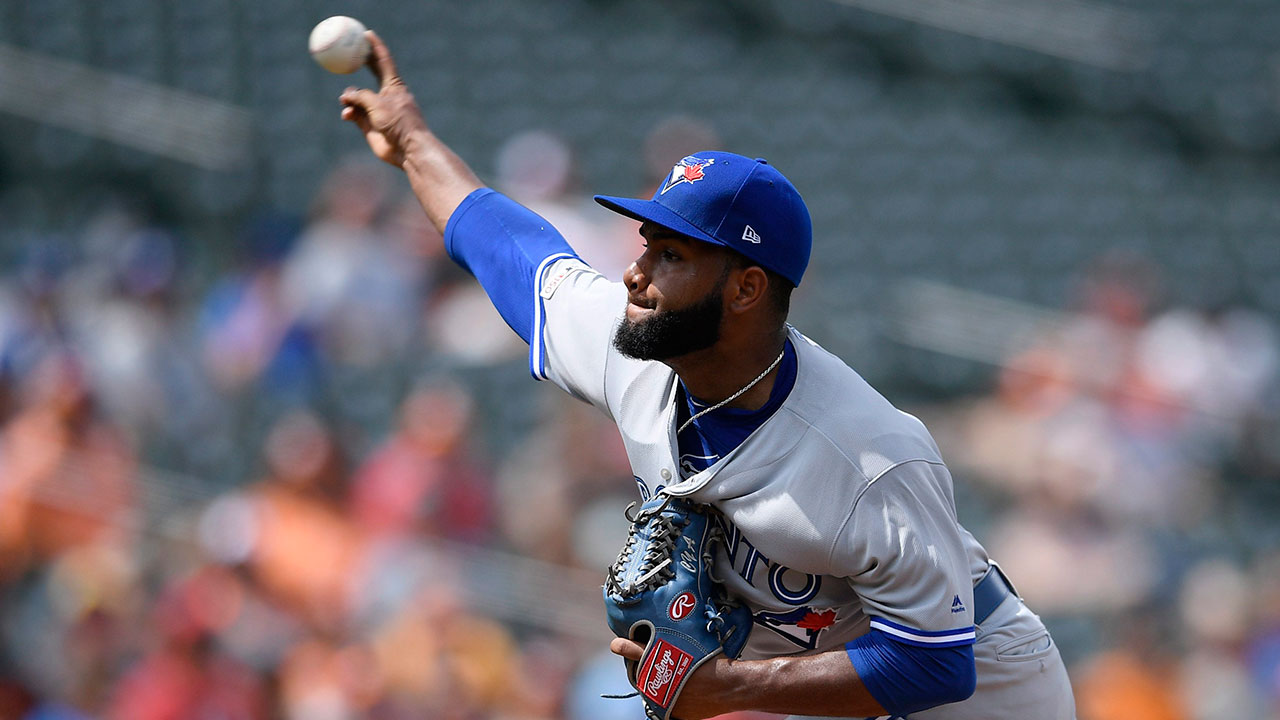
Yennsy Diaz made his MLB debut with the Blue Jays earlier this season against the Baltimore Orioles. (Nick Wass/AP)
Double-A New Hampshire Fisher Cats
Record: 63-76
Finish: Fifth in Eastern League’s Eastern Division
Patrick Murphy: Hard-throwing righty was on cusp of big-league promotion when umpires ruled that a toe touch in his delivery was illegal, prompting him to step back to refine his motion. Had started to make gains with new mechanics, picking up some extra velocity, but experienced shoulder fatigue and was shut down.
"We’re going to prioritize his rest and recovery and have him head into the off-season like that. Kudos to Patrick for having to make a significant delivery adjustment midway through the season and attacking it with a positive mindset. When he came back we saw a little more life on the fastball and talking with Patrick, his gathering and his timing was probably a little bit improved there, and it helped the fastball play a little bit better. He’s always had that outpitch curveball and he’s getting more comfortable with the changeup. So we were really excited and encouraged by Patrick’s development this year."
Yennsy Diaz: Right-hander debuted in majors Aug. 4 at Baltimore but struggled with his command, walked four batters and was promptly optioned back to double-A.
"The main point of emphasis for Yennsy is developing an out-pitch breaking ball. He put a lot of work into his curveball this year. He developed a slider towards the end of the year, as well. Right now he’s a guy who’s mainly fastball/changeup and we’re focusing on developing that breaking ball."
Hector Perez: Righty struggled with his command into early June but recovered well over final 14 outings, pitching to a 3.97 ERA with 61 strikeouts in 65.2 innings.
"He increased the use of his slider a little bit and that was a good pitch for him. We were really encouraged to see how he responded to some of those early season outings. He put the work in and committed to his delivery and controlling the zone a little bit better."
Advanced-A Dunedin Blue Jays
Record: 80-55
Finish: First in Florida State League’s North Division
Simeon Woods Richardson: Righty acquired from the Mets as part of the return for Marcus Stroman was promoted to Dunedin despite being 4.9 years below league’s average age for pitchers and posted a 2.54 ERA over six starts with 29 strikeouts in 28.1 innings.
"He’s an exciting pitcher and a really engaging person. He’s got a good fastball, a very good changeup and a breaking ball that has promise, too. Most of all what we’re excited about was how easily he fit in with the clubhouse and how he approached his work every day."
Low-A Lansing Lugnuts
Record: 68-71
Finish: Fifth in the Midwest League’s Eastern Division
Jordan Groshans: The 12th overall pick in 2018 was off to a strong start with a .909 OPS in 23 games in a league where he was 2.2 years below the average age, but a stress reaction to the foot ended up costing him the rest of the year.
"Right now, he’s progressing well. He’s done gradual strengthening exercises. We’re really focusing on him being ready in spring training next year."
Eric Pardinho: The 18-year-old righty missed most of the season after straining a ligament in his elbow during spring training, but returned to post a 2.41 ERA in 33.2 innings over seven starts before back troubles shut him down.
"With the elbow there were no complications once he got back. He’s another guy who experienced some general fatigue and soreness throughout the year and towards the tail end of the season, he developed some soreness in the back. We just decided to shut him down as a precautionary measure. He’ll be on an overall body strengthening program this off-season, and we expect him to be back at full strength during spring training."
Griffin Conine: Hard-hitting right-fielder missed 50 games under suspension for positive test for a banned stimulant, but returned to mash 22 homers in 80 games with a .946 OPS. Counter to that, he struck out 125 times in 348 plate appearances, or 36 per cent.
"As far as the swing and miss, what makes us feel encouraged is the fact that Griffin has identified that himself as a goal to work through. Also, the fact that he didn’t have as many reps as other guys having missed significant time early in the season. We’re obviously pleased with the overall offensive production. Griffin is very, very smart. He knows his body and his swing very well, and he can articulate what he’s working on and why he’s working on it and his work ethic is very solid. When you combine all those things, we feel very good about Griffin heading into next year."
Gabriel Moreno: The 19-year-old catcher went from extended spring training and a likely ticket to rookie ball up to Lansing and outperformed expectations, posting an .823 OPS in 341 plate appearances over 82 games.
"Huge jump. He’s athletic, his swing works really well, he made a lot of strides with his plate discipline, and he’s an exciting player to watch. He’s obviously got a lot of room to grow and learn, but we were really excited about him."
Short-Season-A Vancouver Canadians
Record: 30-46
Finish: Fourth in the Northwest League’s North Division
Adam Kloffenstein: The 19-year-old right-hander taken in the third round last year logged 64.1 innings after two pro frames in 2018, striking out a batter an inning while only walking 23.
"It was exciting to see Kloff this season. He didn’t pitch a ton last year but he really worked on repeating that delivery and he worked on commanding his fastball. He’s got a good two-seamer and complements well with a pretty good slider, too. We were encouraged to see how we respond in that atmosphere in Vancouver."
Alek Manoah: Right-hander selected 11th overall in this year’s draft was handled carefully, throwing only 17 innings over six pro starts.
"We were really pumped up about how badly this kid burns to compete and to win. We heard that from Coulson Barbiche who was the area scout, we heard that from (amateur scouting director) Steve Sanders, and from the guys in the amateur department who knew him best. That’s exactly what we saw when he got here. He goes out there to try to beat you every time, he’s got a power fastball and he’s got a pretty good feel for that slider already, too."
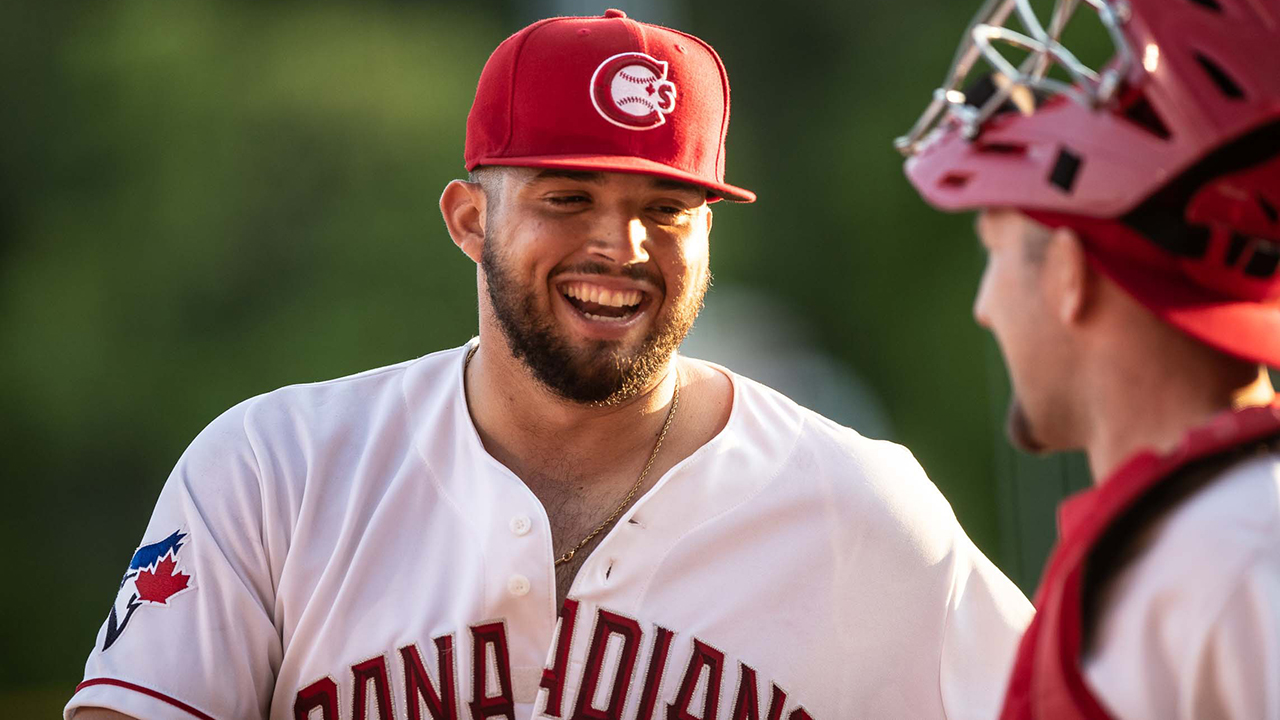
Rookie GCL Blue Jays
Record: 27-23
Finish: Third in the Gulf Coast League’s North Division
Rookie Bluefield Blue Jays
Record: 31-36
Finish: Fourth in the Appalachian League’s East Division
DSL Blue Jays
Record: 35-35
Finish: Third in the Dominican Summer League’s Baseball City Division

